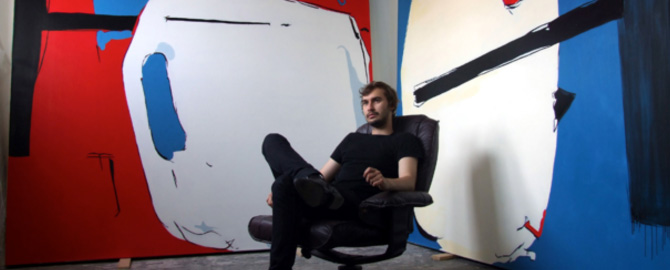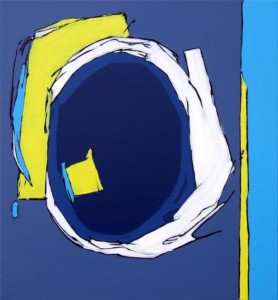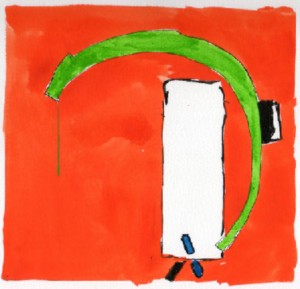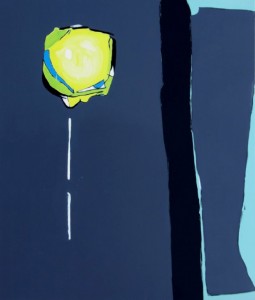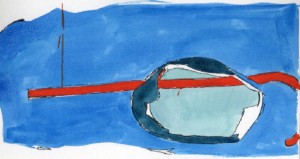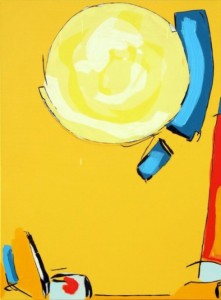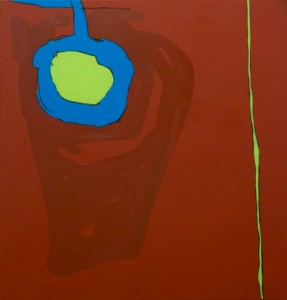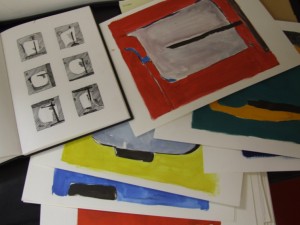Inspired originally by the tremendous work of Chillida, William Bradley’s journey is one of Abstraction. Abstract art about abstract art. He bold use of clean colour and form have an almost graphical element. He has since moved onto the likes of De Kooning, Pollock and Kline, where the focus concentrates on deconstructing and further abstracting elements of their physical work. Bradley takes elusive forms, marks and colour, subtly manipulating them into his own works.
Yorkshire born and bred, Bradley’s work is anything but traditional or conventional.
In his own words
Can you please introduce yourself and describe the time when you first realised that creating was something you absolutely had to do?
My name is William Bradley. I was born in York, UK where I also studied for my BA in Art and Design before graduating from Wimbledon College, University of the Arts London with an MA in Fine Art: Painting. I now divide my time between my studio in London and home in the Yorkshire Dales.
I can’t remember a time when I didn’t make things, its entirely inconceivable to me. I can certainly describe when I first knew I had to pursue Abstraction in some form or another. It was on seeing a major show of sculptures and paper works by Eduardo Chillida at the Yorkshire Sculpture Park that changed everything for me. The way he could continue his exploration of form from epic metal monoliths through to the most economical use of line drawing has left an indelible mark on me.
What concepts are you currently exploring and what will you embark on next?
Whilst my work continues to look at the painted depiction of painted codes, I am increasingly looking to the computer as a tool for the manipulation of these codes. Digitally modifying the scanned watercolours creates a new plan which moves yet another step away from the immediacy of the original authorial mark. The resultant painting may reference gestural marks or codes from the history of Abstraction but this is tinted by it’s digital pre-planning. Thus the gestural elements of the work are less about the intuitive use of paint and more a device concerned with the combining of source material and reference.
This is an ever evolving exploration, the direction of which changes as I stumble across new inspirations. Aside from this I am in the early stages of developing a collaborative project with a sculptor friend of mine which will follow on from Rauschenberg’s erased De Kooning drawing.
On your website you have two separate pages, Paintings and Drawings. The ‘drawings’ are created with wet materials. In your mind what distinguishes a ‘drawing’ from a ‘painting’?
Though I don’t believe there to be any rules which define the two in a wider sense; this became a way for me to separate out the strands of my practice within my own thinking. What I label as my drawings have an immediacy to them where the materials I use allow me to make rapid decisions and lay down ideas quickly, ‘drawing’ in response to source materials. These then form the plans for paintings which are much more about the process of ‘painting’ than the initial works.
Where do you gain inspiration and where do you hope to take your work in the next few years?
For me everything is fair game; inspiration can come from anywhere or anything. I hold no kind of aesthetic hierarchy so a single painting may reference many things. I endeavour to combine different languages which I look to bring together through a cross fading in which a mark by Kline or Pollock becomes just as important as a colour combination from an advert spotted on the tube or a graphicy line of a cartoon from my childhood. A form inspired by a Caro sculpture is rendered in a way that reflects the computer as a tool for image generation. I will continue to explore these themes and where they will lead over the next few years I just can’t say.
What artworks do you find liberating, and whose creations have made you rethink how you approach and execute your own work?
Abstraction is what really excites me, be it painting or sculpture. American Abstract Expressionism is the painting that really makes me sit and stare; though I may not agree with the ideas behind it. Those that have really made me readdress my own work and shaped how I approach it are Danny Rolph, Dan Perfect and Thomas Scheibitz. Seeing their work during my MA really helped me to discover the direction I wanted to take my own practice and the means with which to move it forward at a time when I was questioning the validity of Abstract painting.
In your opinion, in todays economic climate, what role does the artist have in society?
I think the artist’s role is to reflect their interest in the world around them with honesty and integrity. However wider society chooses to respond is ultimately out of the artist’s control.
William Bradley. Born 1984 in Yorkshire, England, U.K. In 2008, Bradley graduated from Wimbledon College of Art, University of the Arts London with an MA in Fine Art: Painting.
In both 2009 and 2011, Bradley was a finalist for the Catlin Prize. In March 2013, Bradley was selected for the group exhibition, Volta NY, EB&Flow, New York,. www.voltashow.com
All images courtesy of William Bradley | www.william-bradley.co.uk
For more information on Hong Kong Art Tutoring please contact:
Gail Deayton
Telephone: +852 9722 8353
Email: gail@hkarttutoring.com

